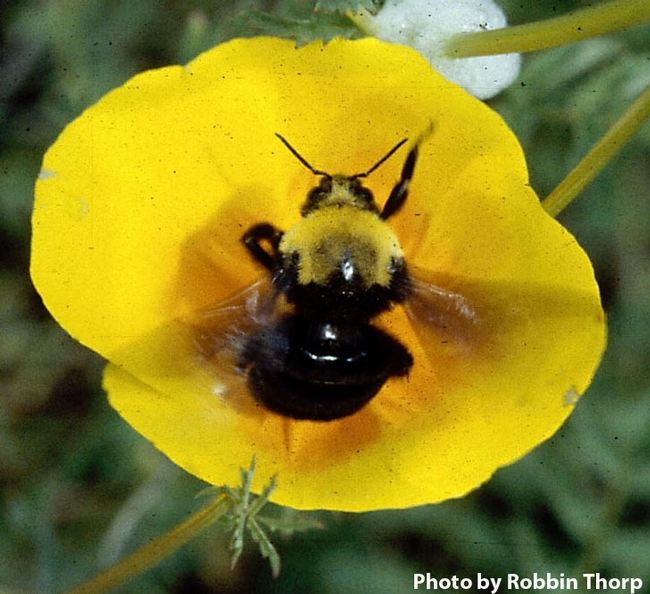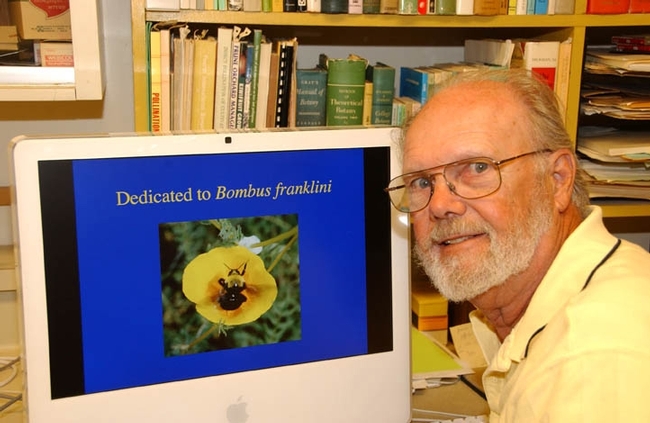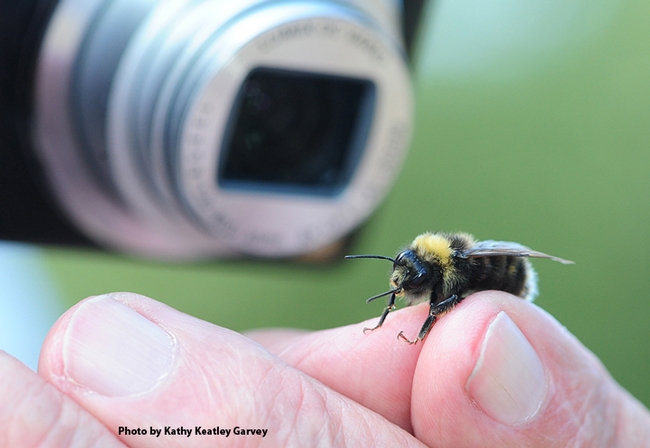
The question is: Where are you? Have you managed to "hide" all these years or are you extinct?
A “search party” of scientists and citizen scientists is forming to look for Franklin's bumble bee and other rare bumble bees from Monday, July 17 through Friday, July 21 at Mt. Ashland, Ore.
Noted bumble bee expert Robbin Thorp, distinguished emeritus professor of entomology at UC Davis, will be there to identify the bees. In addition, he will present a brief introductory training session, showing examples of bumble bees that inhabit the area, “and especially the rare ones we hope to find.”
The event, organized by Jeffrey Dillon, Endangered Species Division Manager, U.S. Fish and Wildlife Service, Portland, Ore., mainly involves searching for Bombus franklini and the endangered Western bumble bee, Bombus occidentalis, in the Mt. Ashland and Siskiyou-Cascade National Monument area. The survey is open to all interested volunteers.
Both bumble bees are on the Red List of Threatened Species of the International Union for Conservation of Nature and Natural Resources (IUCN).
“The objective is to get more eyes out looking for the rare bumble bees,” said Thorp, co-author of Bumble Bees of North America, An Identification Guide.
Thorp will provide a "Bumble Bee 101 Tailgate Course" at 3 p.m. on Monday, July 17. The group will meet him "a few hundred yards west of the Mt. Ashland ski resort (just before reaching the gravel road)," Dillon said. Thorp also will be there Tuesday morning for an informal overview of bumble bees.
Thorp, who has been monitoring Franklin's bumble bee since 1998, hasn't seen the bee since Aug. 9, 2006, when he spotted it in a meadow near Mt. Ashland. In August of 2016 a documentary crew from CNN, headed by John Sutter, followed Thorp to the same meadow. Sutter wrote about Thorp, then 82, in a piece he called "The Old Man and the Bee," a spinoff of Ernest Hemingway's "The Old Man and the Sea."
"That black-and-yellow bee, which looks like so many others except for the characteristic 'U' on is back, is the object of Thorp's obsession," wrote Sutter. "It's a creature he told me flies through his dreams always just out of reach."
Thorp says the distinctively marked bumble bee has the most restricted range of any bumble bee in the world. Its habitat is--or was--a small area of southern Oregon (Douglas, Jackson and Josephine counties) and northern California (Siskiyou and Trinity counties).
Franklin's bumble bee frequents California poppies, lupines, vetch, wild roses, blackberries, clover, sweet peas, horsemint and mountain penny royal during its flight season, from mid-May through September, Thorp points out. It collects pollen primarily from lupines and poppies and gathers nectar mainly from mints.
Thorp sighted 94 in 1998; 20 in 1999; 9 in 2000 and only 1 in 2001. Sightings increased slightly to 20 in 2002, but dropped to 3 in 2003. Thorp saw none in 2004 and 2005; one in 2006; and none since.
In a UC Davis interview in July 2010, Thorp said: “People often ask the value of Franklin's bumble bee. In terms of a direct contribution to the grand scale of human economies, perhaps not much, but no one has measured its contribution in those terms. However, in the grand scheme of our planet and its environmental values, I would say it is priceless.”
“Loss of a species, especially a pollinator, diminishes our global environment,” he said. “Bumble bees provide an important ecological service--pollination. This service is critical to reproduction of a huge diversity of plants that in turn provide shelter, food (seeds, fruits) to diverse wildlife. The potential cascade of effects from the removal of even one localized pollinator may affect us directly and indirectly.”
Meanwhile, Thorp keeps looking.
Dillon emailed survey volunteers that “we plan to spend two full days, Tuesday and Wednesday up on Mt. Ashland, a day over at the Hobart Bluff area (Thursday), and potentially part of a day at Grizzly Peak (Friday morning). Volunteers are welcome for part of the survey or all of it."
Some of the habitat is rugged terrain. All volunteers are encouraged to bring their own nets, and any medication needed if they are allergic to bee stings. Inexperienced folks will be paired with the more experienced, Dillon said.
"If you don't make it over on Monday, we will be up on Mt. Ashland to start the day between 8:30 and 9 a.m. Tuesday and Wednesday. "To find us, go to the Mt. Ashland ski resort. Then continue west past the resort onto the gravel road. Stay basically at the same elevation for about 1 to 1.5 miles past the ski resort--there are other side roads that go down or up oin elevation. You should run into a cluster of vehicles on the side of the road with a number of people nearby that appear to be wandering aimlessly through the alpine meadows with white nets. There will not have been an escape, just fellow bumble bee enthusiasts hoping to be the first to find a Franklin's bumble bee."
“We have already reserved and covered the cost of the group campsite (there is only one) at the Emigrant Lake campground for the week. There are four level tent areas that hold several tents each with plenty of parking space. Showers and restrooms are a short walk away. Everyone is welcome to camp with us if interested.” The campground is located southeast of Ashland on the north edge of Emigrant Lake (reservoir). "Following the main road through the campground, the group site is basically the last campsite area before heading around the lake--it will be on your left. On Monday, July 17, we will probably get there between 5:30 and 6 p.m. We have already covered the cost of the campsite.
For further information, Dillon's office number is (503) 231-6197 and his email is jeffrey_dillon@fws.gov
Results of the 2016 U.S. Fish and Wildlife Service, Portland, Ore., survey:
- Bumble bee species found at Mt. Ashland on July 18/19, 2016:
Bombus mixtus, B. melanopygus, B. bifarius, B. vosnesenskii, B. flavifrons, B. occidentalis, B. appositus, and B. insularis. Had a report of a B. vandykei but did not see it. - Bumble bee species found at Hobart Bluff trailhead area July 20, 2016:
Bombus mixtus, B. vosnesenskii, B. flavifrons, B. appositus, B. californicus, B. griseocollis, B. flavidus, and B. insularis. - Bumble bee species found at Grizzly Peak area July 21, 2016:
B. vosnesenskii, B. flavifrons, and B. appositus.
Attached Images:

Bumble bee expert Robbin Thorp of UC Davis with his computer screen showing a photo he took of Franklin's bumble bee, now feared extinct. He last saw it on Aug. 9, 2006 in a meadow near Mt. Ashland. (Photo by Kathy Keatley Garvey)

This is the Western bumble bee, Bombus occidentalis, found Aug. 15, 2012 by Mt. Shasta. It is on the endangered list. (Photo by Kathy Keatley Garvey)